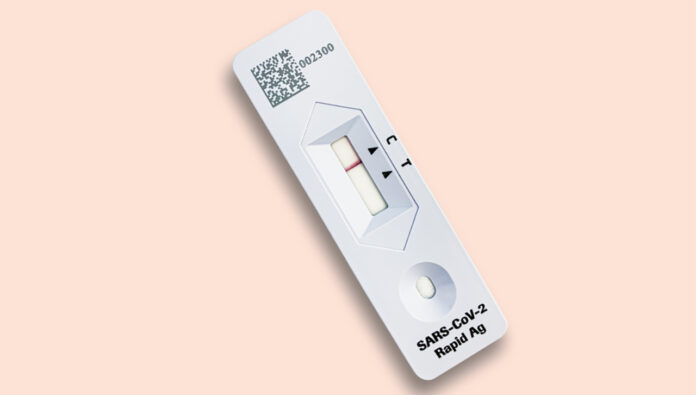While pharmacists are now (very) familiar with rapid antigen tests (RATs) for COVID-19 testing, the practice of observed RATs for the purpose of international travel to some destinations is relatively new.
So how do you offer the service safely and efficiently to ensure there are no nasty surprises for patients at the airport?
Check for symptoms first!
Patients seeking observed RATs should be screened negative for respiratory symptoms before entering a consultation room. Any person with symptoms should be redirected to alternative testing services, such as PCR pathology testing centres.
Masks are a must. Eye protection is recommended (essential for saliva tests)
In consultation rooms, patients and pharmacists need to wear face masks, except for the patient when collecting the test sample or confirming patient identity.
Some oral fluid tests require patients to cough – making them an aerosol-generating procedure. Eye protection and N95/P2 masks are required health worker PPE for aerosol-generating procedures.
Pharmacists must maintain chain-of-custody of the test
The patient should be observed administering the RAT consistent with directions for use. The test must be listed on the ARTG and should be supplied by the pharmacy, not the patient. It should be under the immediate supervision of the pharmacist until a valid result is returned, to eliminate any risk of substitution. For example, patients should not be left in a room alone with a test.
Ensure your service fee fully reflects the cost of the service
While the time taken to administer/observe the test is relatively short, the documentation and patient flow are much more time-consuming. Fees should reflect all business costs, including staff time (e.g. triage, consultation, cleaning), resource use (i.e. consultation room time), consumables (e.g. PPE, RAT, printing) and any fixed costs.
Check the documentation – then check again!
Spelling or numerical errors may prevent travel; accuracy of records is paramount! Pharmacists should check every field for accuracy, as well as encourage patients to spot spelling or numerical errors. Ensure records are retained for easy retrieval.
At a minimum, the documentation must include:
- patient name, date of birth and passport number
- type of RAT used
- date and time of test
- test result (positive or negative)
- name of supervising pharmacist
- health provider details (e.g. pharmacy letterhead).
This is not a full list of considerations for providing this service – templates, air filtration, waste disposal, sanitation and staff training also need consideration. You should self-assess your service against Standard 10: Screening and Risk Assessment in the Professional Practice Standards.
Standard 10: Professional Practice Standards
| CRITERIA FOR SERVICE DELIVERY
10.1 Patient-centred care 10.2 Collaborative care 10.3 Policy and procedures 10.4 Education and delivery 10.5 Environment and equipment 10.6 Service delivery 10.7 Assessment, consultation and reconciliation 10.8 Counselling 10.9 Monitoring, review and follow-up 10.10 Documentation 10.11 Risk management and evaluation |
PETER GUTHREY MPS is PSA’s Senior Pharmacist – Strategic Policy.
Need some advice? Lodge your own question at editorial@australianpharmacist.com.au



 National Medicines Symposium 2024 speakers (L to R): Steve Waller, Professor Jennifer Martin, Professor Libby Roughead, Tegan Taylor[/caption]
National Medicines Symposium 2024 speakers (L to R): Steve Waller, Professor Jennifer Martin, Professor Libby Roughead, Tegan Taylor[/caption]


 This CPD activity is sponsored by Reckitt. All content is the true, accurate and independent opinion of the speakers and the views expressed are entirely their own.[/caption]
This CPD activity is sponsored by Reckitt. All content is the true, accurate and independent opinion of the speakers and the views expressed are entirely their own.[/caption]







